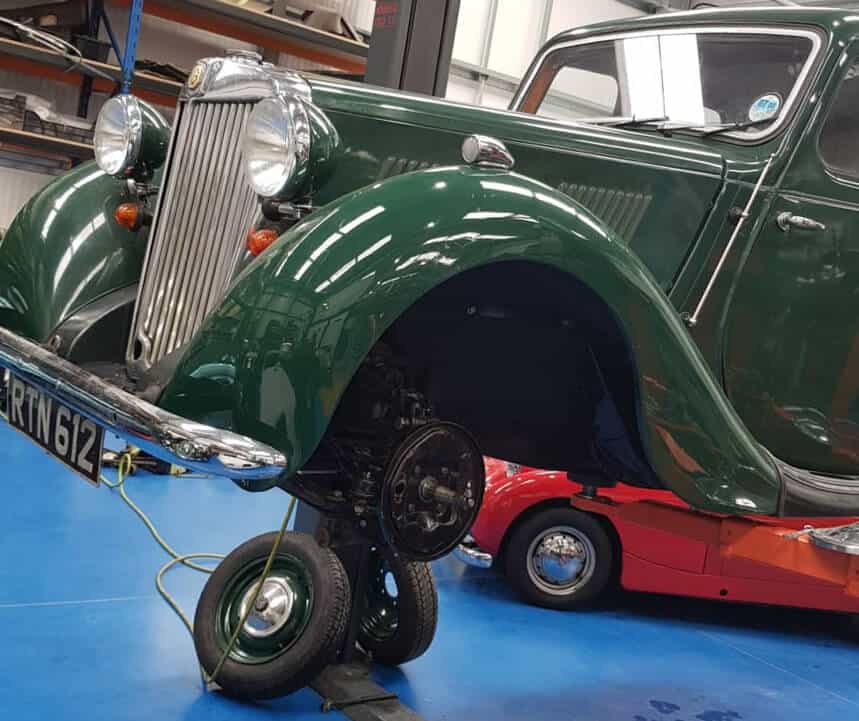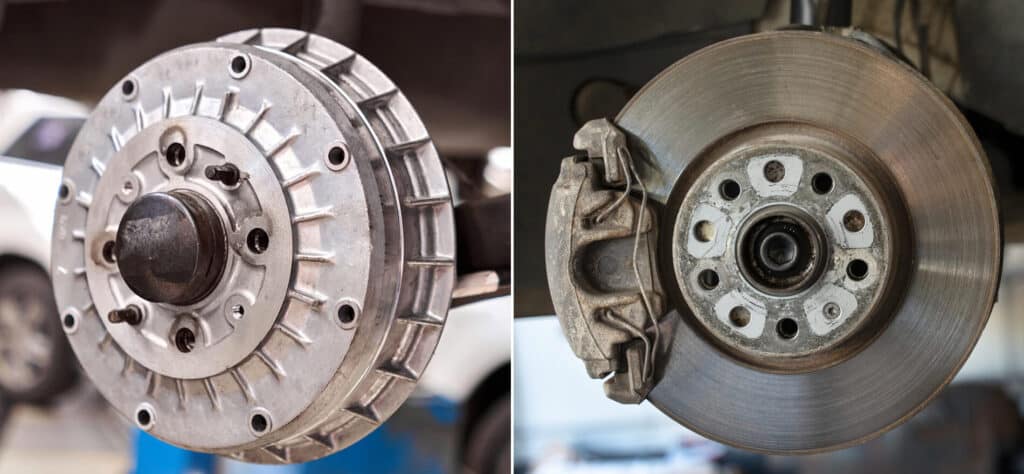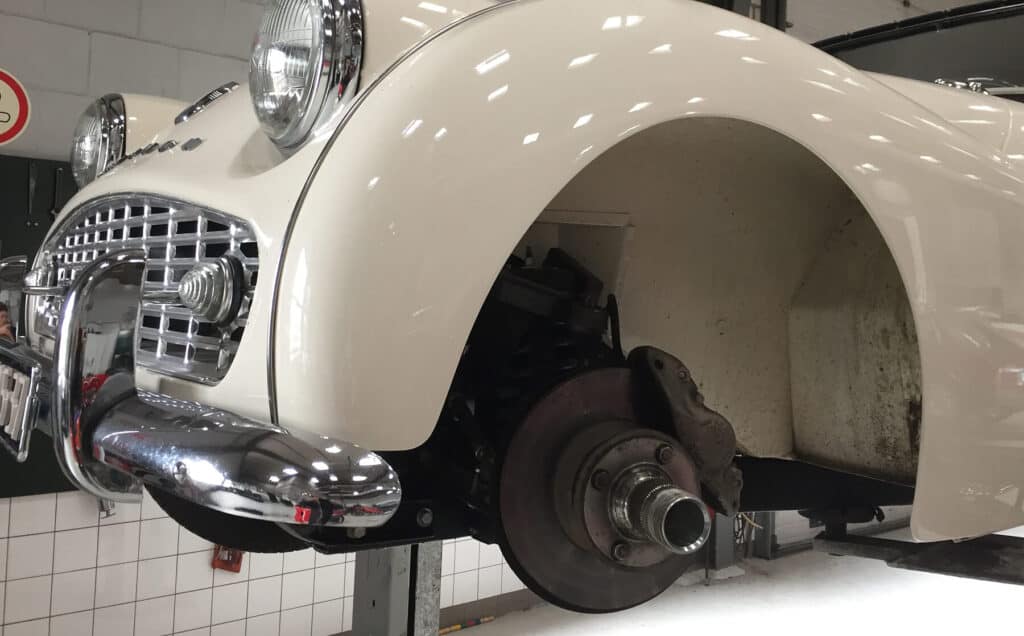The Importance of Brake Maintenance for Classic Cars
The Importance of Brake Maintenance for Classic Cars: Proper brake maintenance is essential for all vehicles, particularly classic cars with their older, delicate components and unique brake system configurations. Ensuring optimal performance, safety, and authenticity requires special care, attention, and specialized knowledge in maintaining these classic vehicles’ brake systems.

Classic Car Brake Systems: Understanding the Differences
• Drum Brakes vs. Disc Brakes: While modern vehicles typically utilize disc brakes, many classic cars are equipped with drum brakes. Drum brakes rely on a set of brake shoes that press against the inside of a rotating drum to slow the vehicle. Although drum brakes may not provide the same level of performance as disc brakes, they are often more straightforward to maintain and can be more consistent with a classic car’s original appearance.
• Single Master Cylinder vs. Dual Master Cylinder: Many classic cars feature a single master cylinder brake system, while modern vehicles typically employ a dual master cylinder system. The single master cylinder setup can pose a safety risk, as a single point of failure can lead to a complete loss of braking ability. In contrast, a dual master cylinder system splits the braking system into two separate circuits, reducing the risk of total brake failure.
• Vintage Brake Components and Materials: Classic cars often contain brake components made from materials that differ from those used in modern vehicles. For example, asbestos was commonly used in brake pads and shoes in the past, but it has been replaced by safer, more environmentally friendly alternatives in newer vehicles. Identifying and sourcing authentic replacement parts for classic car brake systems can be a challenge but is essential for maintaining the vehicle’s original appearance and performance.
Common Brake Issues Unique to Classic Cars
• Corroded Brake Lines: Brake lines in classic cars are often made of steel, making them susceptible to corrosion over time, especially if the vehicle has been exposed to moisture or harsh environments. Corroded brake lines can lead to leaks and compromised brake performance, making it essential to inspect and replace these components as needed.
• Deteriorating Brake Hoses: Rubber brake hoses found in classic cars can deteriorate over time, becoming brittle and cracking. This deterioration can lead to leaks and a loss of braking efficiency. Regular inspection and timely replacement of brake hoses are crucial to maintaining your classic car’s braking performance.
• Aging Brake Components: Classic car brake components, such as wheel cylinders, calipers, and master cylinders, can wear out over time and may require rebuilding or replacement. Keeping an eye on these components’ condition and addressing any issues promptly is essential for maintaining the safety and performance of your classic car’s braking system.
Brake Fluid Considerations for Classic Cars
• Choosing the Right Brake Fluid: Selecting the appropriate brake fluid for your classic car is vital for maintaining its brake system’s performance and longevity. Older vehicles may require specific brake fluid types, such as DOT 3 or DOT 4, to ensure compatibility with the system’s components. Always consult your vehicle’s manual or a classic car specialist to determine the correct brake fluid for your vehicle.
• The Importance of Regular Fluid Changes: Brake fluid can absorb moisture over time, leading to reduced performance and potential corrosion within the brake system. Regularly changing your classic car’s brake fluid can help prevent these issues and maintain optimal braking performance.
• Preventing Brake Fluid Contamination: Keeping your classic car’s brake fluid clean and free of contaminants is essential for preserving the brake system’s components. Always use a clean, sealed container when adding brake fluid to your vehicle and avoid exposing the fluid to dirt, dust, or moisture. Additionally, never mix different types of brake fluid, as this can cause compatibility issues and potentially damage your classic car’s braking system.

Brake Pad and Shoe Maintenance for Classic Cars
• Assessing Wear and Tear: Regularly inspecting the brake pads and shoes on your classic car is crucial for identifying wear and ensuring optimal braking performance. Worn brake pads or shoes can reduce braking efficiency and potentially damage other components, such as the rotors or drums. Replace any worn or damaged parts as needed to maintain your vehicle’s safety and performance.
• Selecting Compatible Replacement Components: When replacing brake pads or shoes on a classic car, it’s essential to choose compatible components that match the vehicle’s original specifications. Using the wrong type of brake pad or shoe material can lead to reduced performance, increased wear, or damage to other brake system components. Consult your vehicle’s manual or a classic car specialist to determine the appropriate replacement parts for your specific vehicle.
• Break-In Procedures for Vintage Brake Systems: Properly breaking in new brake pads or shoes is essential for ensuring optimal performance and longevity. The break-in process, also known as “bedding-in,” involves a series of gradual speed reductions and cooling periods to help evenly transfer friction material from the brake pads or shoes onto the rotors or drums. This process can vary depending on the specific components and materials used in your classic car’s brake system, so consult your vehicle’s manual or a classic car expert for guidance.
Upgrading Classic Car Brake Systems
• Disc Brake Conversions: Converting drum brakes to disc brakes is a popular upgrade for classic cars, as it can significantly enhance braking performance and safety. This modification makes your vehicle more enjoyable and reliable to drive, but it’s crucial to consider its effect on the originality and value of your classic car.
• Dual Master Cylinder Installation: Upgrading from a single master cylinder brake system to a dual master cylinder setup in a classic car can improve safety by reducing the risk of total brake failure. This upgrade is particularly beneficial for classic cars used for regular or performance driving, but the impact on the vehicle’s authenticity should be considered.
• Performance Brake Component Options: There are various performance brake components available for classic cars, such as high-performance brake pads, rotors, and calipers. These upgrades can enhance your vehicle’s braking performance but should be weighed against the potential effect on your classic car’s authenticity and overall value.
Tips for Preserving Your Classic Car’s Brake System:
• Regular Inspections and Maintenance: To keep your classic car’s brakes in top condition, perform regular brake system inspections and maintenance. Routinely check brake pads, shoes, rotors, drums, hoses, and lines for wear or damage, and promptly address any issues to maintain safety and performance.
• Proper Storage, Care, and Driving Techniques: Store your classic car in a climate-controlled, dry environment to minimize corrosion, deterioration, or damage. Periodically driving your classic car helps keep its brake system and other mechanical components in good working order. Adopt a gentle driving style, avoiding aggressive or sudden braking, and maintain a safe following distance to minimize hard stops and reduce wear on components.
Finding a Classic Car Brake Specialist: Why Expertise Matters
Working with a classic car brake specialist can help ensure that your vehicle’s brake system is maintained and repaired correctly. These experts possess the knowledge and experience necessary to handle the unique challenges and nuances associated with classic car brake systems. They can provide guidance on selecting the appropriate components, maintaining authenticity, and addressing any issues specific to your vehicle’s brake system.

Balancing Authenticity and Safety in Classic Car Brake Maintenance
When maintaining the brake system of a classic car, it’s essential to strike a balance between preserving the vehicle’s original appearance and ensuring its safety and performance. While some upgrades and modifications can improve braking performance, they may also impact the car’s authenticity and value. Consult with a classic car specialist to determine the best approach for maintaining your classic car’s brake system, considering both its historical integrity and your personal driving needs.
Conclusion: Ensure Optimal Brake Performance and Longevity for Your Classic Car
Brake system maintenance for classic cars requires a unique set of considerations, from understanding the differences in brake components and materials to addressing the challenges posed by aging and deteriorating parts. By staying informed about your vehicle’s specific brake system, seeking professional assistance when necessary, and following best practices for maintenance and preservation, you can ensure that your classic car remains safe, enjoyable, and valuable for years to come.
